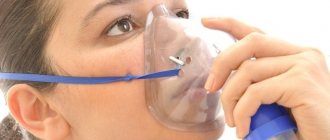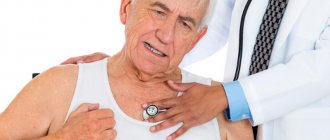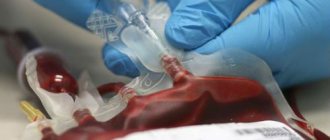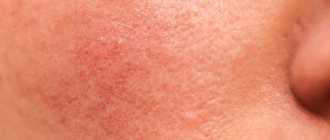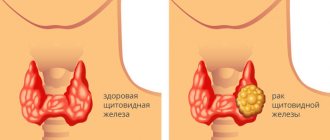Normal breathing of a healthy person (vesicular) is characterized by rhythmic respiratory movements, with a predominance of inhalation over exhalation. In certain diseases, it can be disrupted, causing changes in the frequency and depth of inhalations and exhalations. Biot and Kussmaul breathing are among these types of disorders. Pathological breathing is an important symptom that has its own individual pathogenesis. Based on this, it is possible to assume a leading diagnosis for the patient and begin immediate treatment.
How?
The breathing of a healthy person is rhythmic, with the same depth and duration of the inhalation and exhalation phases. With some types of shortness of breath, the rhythm of respiratory movements may be disrupted due to changes in the depth of breathing (Kussmaul breathing), the duration of inspiration (inspiratory dyspnea), exhalation (expiratory shortness of breath) and the respiratory pause. A dysfunction of the respiratory center can cause a type of shortness of breath in which, after a certain number of respiratory movements, a visible (from several seconds to 1 minute) prolongation of the respiratory pause or short-term breath holding (apnea) occurs. This type of breathing is called periodic breathing.
Biot's breathing is characterized by rhythmic but deep respiratory movements, which alternate at approximately equal intervals with long respiratory pauses.
Breathing disorders
General information
Respiration is a set of physiological processes that provide oxygen to human tissues and organs. Also, during the process of breathing, oxygen is oxidized and removed from the body through the metabolism of carbon dioxide and partially water. The respiratory system includes: nasal cavity, larynx, bronchi, lungs. Breathing consists of stages:
- external respiration (provides gas exchange between the lungs and the external environment);
- gas exchange between alveolar air and venous blood;
- transport of gases through the blood;
- gas exchange between arterial blood and tissues;
- tissue respiration.
Disturbances in these processes can occur due to illness. Serious breathing problems can be caused by the following diseases:
- bronchial asthma;
- lung disease;
- diabetes;
- poisoning;
- shock.
External signs of breathing problems allow you to roughly assess the severity of the patient’s condition, determine the prognosis of the disease, as well as the location of the damage.
Causes and symptoms of breathing problems
Symptoms of impaired breathing can be caused by various factors. The first thing you should pay attention to is your breathing rate. Excessively rapid or slow breathing indicates problems in the system. is also important . Rhythm disturbances lead to different time intervals between inhalations and exhalations. Also, sometimes breathing may stop for a few seconds or minutes, and then reappear. Lack of consciousness may also be due to problems in the respiratory tract. Doctors focus on the following indicators:
- noisy breathing;
- apnea (stopping breathing);
- rhythm/depth disturbance;
- Biota breath;
- Cheyne-Stokes breathing;
- Kussmaul breathing;
- quietpnea.
Let us consider the above factors of breathing problems in more detail. Noisy breathing is a disorder in which breathing sounds can be heard from a distance. Disturbances occur due to decreased airway patency. Can be caused by diseases, external factors, rhythm and depth disturbances. Noisy breathing occurs in the following cases:
- damage to the upper respiratory tract (inspiratory dyspnea);
- swelling or inflammation in the upper respiratory tract (shortness of breath);
- bronchial asthma (wheezing, expiratory shortness of breath).
When breathing stops, the disturbances are caused by hyperventilation of the lungs during deep breathing. Apnea causes the level of carbon dioxide in the blood to decrease, disrupting the balance of carbon dioxide and oxygen. As a result, the airways narrow and air movement becomes difficult. In severe cases there is:
- tachycardia;
- decreased blood pressure;
- loss of consciousness;
- fibrillation.
In critical cases, cardiac arrest is possible, since respiratory arrest is always fatal to the body. Doctors also pay attention during examination to the depth and rhythm of breathing. These disorders may be caused by:
- metabolic products (slags, toxins);
- oxygen starvation;
- traumatic brain injuries;
- bleeding in the brain (stroke);
- viral infections.
Lesions of the central nervous system cause Biota respiration. Damages to the nervous system are associated with stress, poisoning, and cerebrovascular accidents. May be caused by encephalomyelitis of viral origin (tuberculous meningitis). Biot's breathing is characterized by alternating long pauses in breathing and normal, uniform breathing movements without disturbing the rhythm.
An excess of carbon dioxide in the blood and a decrease in the functioning of the respiratory center causes Cheyne-Stokes breathing. With this breathing head start, respiratory movements gradually become more frequent and deepen to a maximum, and then move on to more shallow breathing with a pause at the end of the “wave”. Such “wave” breathing is repeated in cycles and can be caused by the following disorders:
- vascular spasms;
- strokes;
- cerebral hemorrhages;
- diabetic coma;
- intoxication of the body;
- atherosclerosis;
- exacerbation of bronchial asthma (attacks of suffocation).
In children of primary school age, such disorders are more common and usually disappear over the years. Other causes may include traumatic brain injury and heart failure.
A pathological form of breathing with rare rhythmic inhalations and exhalations is called Kussmaul breathing. Doctors diagnose this type of breathing in patients with impaired consciousness. This symptom also causes dehydration.
The type of shortness of breath called tachypnea causes insufficient ventilation of the lungs and is characterized by an accelerated rhythm. It is observed in people with severe nervous tension and after heavy physical work. It usually goes away quickly, but may be one of the symptoms of the disease.
Treatment
Depending on the nature of the disorder, it makes sense to contact an appropriate specialist. Since breathing problems can be associated with many diseases, if you suspect asthma , consult an allergist. In case of intoxication of the body, a toxicologist will help.
A neurologist will help restore normal breathing rhythm after shock and severe stress. If you have a history of infections, it makes sense to contact an infectious disease specialist. For a general consultation with mild breathing problems, a traumatologist, endocrinologist, oncologist, or somnologist can help. In case of severe breathing problems, you should immediately call an ambulance.
Diagnostics:
- taking anamnesis;
- auscultation;
- immunological studies;
- chest x-ray;
- computed tomography of the lungs;
- Ultrasound of the chest;
- computed tomography of the chest;
- ECG of the cardiovascular system;
- Ultrasound of the cardiovascular system;
- study of external respiration function;
- determination of blood gas composition;
- fibrobronchoscopy;
- angiography of pulmonary vessels;
- polysomnography;
- studying the mechanics of breathing and the function of respiratory muscles;
- exercise tests;
- general blood analysis;
- blood chemistry;
- general urine analysis.
Kussmaul's Breath
Kussmaul's symptom is one of the types of pathological breathing, which is characterized by deep audible breaths, shortening of respiratory cycles and an increase in the time between respiratory movements.
This phenomenon was first described in 1874 by the German physician Kussmaul during his presentation of a patient with type 1 diabetes mellitus.
Causes
This pathological type can be called hyperventilation, which occurs against the background of prolonged hypoxia of the body. Its causes may be the following diseases:
- traumatic brain injury;
- neuroinfection;
- organic brain lesions;
- diabetic coma;
- stroke.
Kussmaul breathing is an unfavorable prognostic sign. Its occurrence indicates a severe disruption of the processes of excitation and inhibition in the central nervous system. In hypoglycemic coma, Kussmaul breathing is a sign of the terminal phase of acidosis (impaired carbohydrate metabolism with increased formation of ketone bodies and a decrease in blood bicarbonates).
Pathogenesis
Most often, Kussmaul's symptom develops in patients suffering from diabetes mellitus when they do not follow the diet and rules for taking medications. In this case, the development mechanism begins in patients with diabetic ketoacidosis (a type of metabolic acidosis). This condition is characterized by an increase in glucose levels, which increases the formation of ketone acids, which lower blood pH.
In order to remove excess CO2 from the body and thereby increase the alkalinity of the blood, respiratory alkalosis develops compensatoryly - the respiratory movements of patients become frequent and superficial. As acidosis progresses, the patient's amplitude of respiratory movements will increase along with their depth. In this case, compensation will not occur, since removing CO2 from the body will not solve the main cause of acidosis. Washing CO2 out of the blood with a simultaneous decrease in bicarbonates will lead to uncontrolled deep breaths and shortened respiratory cycles - Kussmaul syndrome.
Read also: Why does a person snore during sleep and what to do about it
Kussmaul breathing on a spirogram:
Treatment:
The doctor can select an individual treatment program based on the results of laboratory tests, diagnosis and severity of the disease. Treatment of the disease can be carried out both on an outpatient basis and at home. The doctor may prescribe general tonics, vitamin therapy, herbal medicine, massage, and diet. As well as immunomodulatory, anti-inflammatory, antiviral drugs, as well as physiotherapy, infusion therapy. Diffusion therapy and oxygen therapy can be used to relieve severe attacks.
At the Multidisciplinary Pulmonology Center you will be provided with high-quality medical care using modern medical technologies and at a high level.
Breath Biota
Biot's symptom is a pathological type of breathing, which is characterized by a period of rapid respiratory movements and a period of apnea (complete cessation of breathing) with further repetition of the cycle. This syndrome was named Biota in honor of the French doctor.
Causes
Any pathology has its causes. This is due to the peculiarities of pathogenesis, which determine the depth of respiratory movements and their unique cyclicity, which is reflected in the spirogram graph.
The cause of the development of Biot's symptom is the extinction of the excitability of the respiratory center. This occurs under the following conditions:
- hypoxia;
- shock;
- intoxication;
- brain damage (organic, infectious, traumatic).
The cause of hypoxia may be the presence of atherosclerosis of the cerebral arteries. In this case, their lumen narrows, which impairs the flow of oxygen to the brain, causing a decrease in the excitability of the respiratory center.
Infectious diseases that cause Biot's symptom include encephalitis - the process affects the medulla oblongata itself, affecting the respiratory center, disrupting the processes of excitation and inhibition in it.
Abscesses, hemorrhages and brain tumors cause compression of all structures of the central nervous system, which also leads to deterioration in the functioning of the medulla oblongata.
Read also: Types and symptoms of respiratory failure
Pathogenesis
Breathing regulation is based on the feedback principle. Chemoreceptors record the partial pressure of blood gases, compare them with the required values and transmit information to the respiratory center, where stimulation of the necessary structures occurs. In shock conditions, hypoxia and organic diseases of the brain, due to damage to the medulla oblongata, the threshold of excitability of the respiratory center increases. The normal concentration of CO2 in the blood in this case does not have the desired effect on it, which leads to temporary apnea.
A further increase in the partial pressure of CO2, reaching significant values, excites the medulla oblongata, which serves as an impetus for the resumption of respiratory movements. After normalization of CO2, the entire cycle is repeated, creating Biota symptoms.
Biot's respiration on a spirogram:
Treatment tactics
Modern approaches to treatment include:
- Psychotherapeutic sessions , that is, the patient himself changes his attitude towards the disease. Experienced doctors explain the essence of the disease and show that it does not have serious consequences that cannot lead to death. Understanding this frees many patients from the obsessive clinical picture.
- Respiratory complexes . Today, several methodologies are able to correct breathing. They are based on holding your breath while inhaling and extending your exhalations. If there is a lack of air, the technology of breathing into a bag made of airtight material is used. This increases the concentration of beneficial carbon dioxide in the blood and eliminates symptoms. Belly breathing through diaphragmatic movements is widely popular. With this technique, exhalation is twice as long as inhalation. Practice breathing through one nostril. This is how air exchange returns to normal, oxygen levels, as well as carbon dioxide, are leveled out.
- Physiotherapy is of no small importance for the body : relaxing baths, inhalations, swimming pool, massages and aromatherapy.
- Normalization of metabolism through magnesium, as well as calcium and beneficial glutamic acid.
- Internal tensions are also eliminated with medications. They reduce excitability. Antidepressants and anxiolytics have a great effect. The treatment must be supervised by a doctor.
An integrated approach to therapy guarantees complete cure for most patients. It is also worth remembering that breathing disorders are, in principle, curable; for example, for apnea, CPAP therapy is used. The main thing is not to self-medicate and not to start the process, but to consult a qualified doctor in a timely manner.
